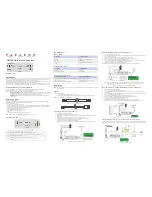
4
1. Important information
Please read this manual completely and attentively before using the product for the first time. Keep this manual. It is part of the
product.
1.1 Safety instructions
Caution:
Risk of injury!
Due to the detailed reproduction of the original and the intended use, this product can have peaks, edges and breakable parts.
Tools are required for installation.
Electrical hazard!
Never put the connecting wires into a power socket! Regularly examine the transformer for damage. In case of any damage,
do not use the transformer.
Make sure that the power supply is switched off when you mount the device and connect the cables! Only use VDE/EN tested
special model train transformers for the power supply! The power sources must be protected to avoid the risk of burning cables.
1.2 Using the product for its correct purpose
This product is intended:
- For installation in model train layouts and dioramas.
- For connection to contact track sections (only for third-rail tracks) or track contacts.
- For operation within a model train digital system with a feedback bus which is compatible to s88 (like the Fleischmann Twin-
Center, Märklin Digital, Uhlenbrock Intellibox etc.).
- For operation in dry rooms only.
Using the product for any other purpose is not approved and is considered inappropriate. The manufacturer is not responsible for
any damage resulting from the improper use of this product.
1.3 Checking the package contents
Check the contents of the package for completeness:
- Feedback decoder
- 18 plugs
- 2 screws
- s88-Bus cable
- Manual
2. Introduction
In order to control a model railroad layout according to the prototype, e. g. by PC or by an automatic route control system (Märklin
Memory, IB-Switch from Uhlenbrock), constant information on track occupancy is essential. The s88 bus has become the standard
for digital systems for directing these occupied messages to the command station. The feedback decoders are connected to this
bus in a chain and detect the occupied states “on-site” and send them to the digital command station via the s88 bus.
Item 5217 is such a feedback decoder which can read in 16 feedback contacts.
A feedback decoder must be provided with information at its inputs. This can be achieved with potential-free, train-triggered switch
contacts such as switching tracks and reed contacts. Such “instant” switch contacts have the property to only provide a pulse of
current for the short moment in which the train (or even a particular car of the train) moves over the contact. This does not always
make sense. For a PC control system, for example, it is desirable to be able to directly recognize the occupied sections of the route
after the system is switched on. Cars that are left standing should also be recognized. This requires constant contacts that provide
a signal for as long as the monitored route section is occupied by a vehicle. For certain third-rail track types (Märklin C- and
K-track), this can be achieved using grounding rail sections insulated on one side (“contact track sections”). A vehicle located on
it bridges the left and right grounding rails, thereby triggering a signal.
However, this quite simple procedure to detect occupied track sections does not work in turnout areas, because the left and right
grounding rail sections there can only be electrically separated from each other with a lot of handwork. This type of occupation
detection is also not possible for tracks without a third rail. For this track type, both rail profiles have a different polarity, and
bridging with an uninsulated set of wheels would lead to a short circuit.
Our feedback decoder with track occupancy detector item 5233 was developed to solve this problem. It consists of a “half”
feedback decoder item 5217 to whose 8 inputs sensitive electronic current sensors are connected (via “optocouplers”). To these
current sensors, you can then connect either the turnouts areas of third-rail tracks (i. e. their insulated third rail) or the sections of
tracks insulated at one side without third rail (two-rail/two conductor system).
The current sensors recognize every power-consuming vehicle on the monitored section of track. These can be locomotives or
illuminated cars with their own power pickups (center slider, wheel contact).
For two-rail systems, it is also possible to bridge the axle insulation of the wheel sets of unlighted cars with high resistance using
resistor paint (do not confuse with silver conductor paint!). This turns the cars into (slight) power consumers so that they are
recognized by the power sensors of item 5233. As an alternative for H0, the resistor wheel sets (40186 and 40187) from Roco
can also be used.
The feedback decoder item 5217 is compatible with the Märklin digital decoder s88. The 16 inputs of the decoder are qualified for
EN


























